Advanced DIR/Floortime practitioner Stephanie Peters joins us today to discuss the phase that those new to Floortime go through, especially when coming from other approaches to autism supports. Stephanie is an occupational therapist with ICDL’s DIR Home Program and has been coaching parents online during the pandemic. Today we discuss the differences in the way we see our neurodiverse children and how that affects our Relationship with them and their capacity to thrive.
The Realization Process
Check yourself
We talked about ambiguous loss before where parents have grief about the unexpected challenges they will face having a neurodiverse child. When you see your child differently, you can let go of your previous expectations and really accept the child who is in front of you. This can take some time, but will allow you to support your child and celebrate with them as they thrive in their development at their own pace. Today we discuss some examples of how to do that.
I shared that it took me at least four years to get out of that let’s fix my child phase to really supporting the child in front of me. It’s a paradigm shift, Stephanie says, for many families because Floortime goes against what many families have previously heard from professionals. She shared that you are always doing reflective practice in Floortime.
Free online parent support drop-in
Don’t miss our weekly online parent support drop-in every Monday at 1pm Eastern! Registration is free.
We want to be aware of what’s happening and respond to the child in the moment, rather than having our own agenda. Do I have a need to have things look a certain way? This is the first step. And we can only do this if we understand where our child is Developmentally, respect their Individual differences, and focus on our Relationship. If we expect our child to act in a way that is developmentally out of reach for our child, we will be putting unrealistic demands on our child.
Stress responses
When we expect too much from our child, we see stress responses that are not voluntary. Stephanie continues to learn what to do when she sees a stress response. In the school setting, she was told to ignore ‘behaviours’ or to redirect them, but that didn’t feel right. Instead she doesn’t shut down, but leans into the stress behaviour, wonders where it comes from and how she can join it. We tend to think that if we ‘let’ our child behave that way, they will learn that it is ok to act like that. But it doesn’t work this way.
Feeling understood
Instead she listens to what the behaviour is telling her. It’s Stephanie saying, “Hmm… something’s not right. You’re telling me that something’s not right.” Once the child feels understood, there is trust which allows the relationship to blossom. She looks to understand why what the child is doing is so important to that child. This is what actually leads to the flexibility we were looking for in the first place. We start from this place of safety.
What is your goal for your child?
Children are not able to learn when they are in fight or flight mode. I don’t want to put my child in fight or flight mode. As a parent, what I want for my child is to be able to relate and communicate with others, and to have abstract and creative thinking rather than someone who is compliant and has to look to others to decide what to do. So how do we connect with our children when we see behaviours that we find it difficult to connect with?
Following your child’s interest
Stephanie doesn’t have a goal for her client to watch YouTube nor to let them have their way all the time. It might look the same but the rationale behind it is very different. Many parents think that if we give in to our child’s interest, they’re just letting them have their way, but the rationale for letting them watch YouTube could be a sign that they have no energy left, something has been too hard and we’ve maxed out their cognitive load, or they’re feeling very stressed so they need to do something very calming and predictable. The challenge is joining in on that and wondering what about that is so fun and relaxing to them.
Stephanie gave an example of a client who enjoyed watching funny videos where a character sat on a chair which broke and he found that funny. She will take up to 10 to 15 minutes of building up the relationship and connection by allowing the child to watch YouTube and acknowledging how fun it was to share the experience. She also gave the child deep pressure to accommodate the child’s sensory needs, pausing and waiting every minute or so for the child to indicate they wanted more deep pressure. From that connection and that sense of trust and shared engagement, the child filled up his body with feeling safe and relaxed.
Next Stephanie would enact the funny part of the video by falling down and crashing on the mat with the attending parent so the child is enjoying a real life experience interacting and playing together. Without getting the ‘gleam in the eye’ first, why would the child have any motivation to play with us when their comfortable YouTube video (or other activity/preference) is right there?
Expanding to promote interaction
We always want to ask why does our child want to do what they’re doing and how can I expand on it? How can I make it rich with my affect to entice them to want to play with me? It’s the relationship that’s so powerful. It will foster our children to communicate what’s inside of them and share their ideas with us. We just need to adjust ourselves to be a supportive ‘actor’ in the child’s ‘movie’ that they ‘direct’. Be a supporting role in their idea, facilitating playful interactions.
The ability to expand is really limitless depending on how creative you are.
Repetition Many of our children will have repetitive play that some parents worry about. But there is a reason for this type of play, just like neurotypical children will play teacher or soldiers every day. Stephanie says to lean in and let the child take charge. Little by little we can then playfully challenge them to shift it. When you lean in, watch your child. Do they trust you a little more? Do they let you in a little more? We often only focus on what we want them to do without offering them the same courtesy.
The Realization
See your child without making demands. What’s a good test of this? When you come to your child do you get a stress response? Do they try to avoid you? If so, remove the demands. Look at what are they doing. Join in with them. It’s ok if they want to do it the same way every time. There is a purpose for what they’re doing. Look for that why behind their behaviour. When you drop your agenda and instead see your child for who they are and what they offer, your realization process begins. Our goals are also to achieve the same milestones. We focus on the developmental process to get them there.
Parent Resources
Please reach our for parent coaching if you are struggling. ICDL offers free consultations, free Thursday mini-seminars, and the weekly online parent support drop-in. Also see Dr. Gil Tippy’s For on the Floor videos, and ICDL’s CEO Jeff’s blog. Check the Resources and Start Here menus on this site as well.
Thank you to Stephanie Peters for sharing her time and experience with us. If you found this insightful, helpful or interesting I hope you will share this post on Facebook or Twitter. Please feel free to comment or share relevant experiences or questions in the Comments section below. Next time we will talk with Dr. Stephen Porges about the Polyvagal Theory and his Safe and Sound Protocol.
Until next time… here’s to affecting autism through play!




Thank you Daria and Stephanie for providing an engaging, enthusiastic and enlightening podcast.
Your podcast is helpful to me as a parent because my 8 year-old daughter is in the process of being assessed for ASD, and as a practitioner because I work in a respite home for children and young people with disabilities such as ASD in the UK. Therefore, learning about Floortime is enhancing my knowledge and understanding on how to promote co-regulation, build positive relationships and support achievement with children and young people with ASD.
I look forward to gaining more learning experiences from you.
Best wishes,
Paul